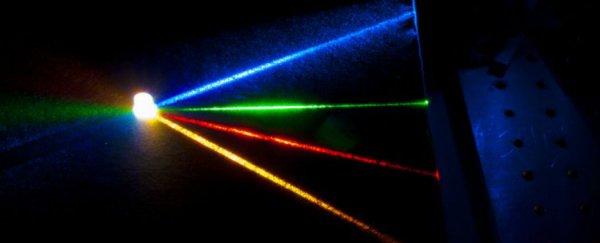Scientists in the US have done what no one else has been able to do: create a white laser light using a monolithic, semiconductor-based setup, in which red, green, and blue lights are emitted simultaneously. Technology developed from the breakthrough could eventually find its way into all kinds of lighting, computer, and television monitors, and even the next generation of Wi-Fi.
Summarising the technical aspects of the research isn't straightforward for the average non-laser expert, but essentially, the team from Arizona State University (ASU) produced a nanoscale semiconductor sheet formed into three segments. With these segments producing red, green, and blue light, a white light could be generated. Usually, semiconductors can only produce one wavelength (and thus one colour).
The main challenge stems from the fact that the semiconductors that produce red, green, and blue light are all very different, and don't necessarily play well together - the ASU team's achievement has been in successfully combining them through careful variations in the temperature and other growth conditions. The researchers found that at such a small scale - the sheet is one-fifth the thickness of a human hair - differences between the semiconductor crystals can be better tolerated.
And the white laser is only part of what this nanoscale conductor sheet can do. It's able to cycle through more colours more efficiently than LED lighting, so it could eventually turn up everywhere from your bedside lamp to your car headlights. It could also lead to speed improvements in the embryonic 'Li-Fi' technology, in which LED lighting is used to connect devices to the Internet - a laser-based setup has the potential to be 10-100 times faster than anything created using LEDs, which itself is potentially 10 times faster than today's Wi-Fi connections.
There are still hurdles to be overcome - not least the high cost of the scientific setup - but it's the first step towards some potentially very exciting innovations. "The concept of white lasers first seems counterintuitive because the light from a typical laser contains exactly one colour, a specific wavelength of the electromagnetic spectrum, rather than a broad-range of different wavelengths," explains Cun-Zheng Ning, the paper's author, in a press release. "White light is typically viewed as a complete mixture of all of the wavelengths of the visible spectrum."
While this isn't strictly speaking the first white laser beam to be produced, earlier efforts have been based around inferior optical fibre technology, or were impractical for everyday use, or consisted of theories without any real evidence to back them up. The results of the study have now been published in Nature Nanotechnology, and in the future, the team wants to experiment with using electricity rather than light pulses to excite the lasers into action.
